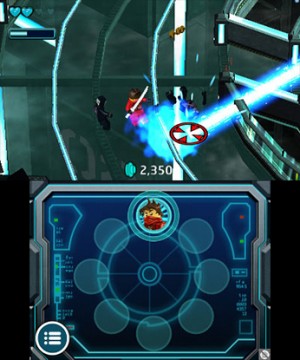Great visuals; Tons of well-made cutscenes; Achievement system adds replayability.
Tedious combat; Solutions to puzzles are constantly revealed; Vehicles levels are a mixed bag; Time attack mode is always on; Poor frame rate and loading times.
When I booted up LEGO Ninjago: Nindroids for the first time and saw the Hellbent Games logo, I almost had a heart attack. The last time I saw that logo was in LEGO Friends, which was the worst game I’ve ever reviewed on Nintendojo. I gave another LEGO game, called LEGO Legends of Chima, a poor review score as well, so I prepared myself for the worst when approaching LEGO Ninjago: Nindroids. Has this game learned from its predecessors?
Well, for every step forward that LEGO Ninjago: Nindroids takes, it also takes two steps backward. One example of this is shown through the combat, which attempts to be more engaging than it actually is. If you’ve ever played a LEGO game before, then you know that the combat is pretty basic due to its design. The only way to damage an enemy is to mash the attack button, which can get really monotonous over time. To improve the combat, the developers added a combo system that displays the number of hits that you have chained while attacking. I like this idea in theory, but the problem with its implementation is that it changes nothing. You’ll still be mashing the attack button in the same way that you’ve done in every LEGO game, leaving much to be desired for this new mechanic.
The game also tries to incorporate puzzles between battles, but they never require any actual thinking. Every single puzzle boils down to finding a specific object and interacting with it. Not only that, but the camera usually zooms into the position of these objects, instructing the player exactly where to go. What is exciting about a puzzle where the game reveals the solution? It’s not a puzzle if there is absolutely nothing to figure out!

In an attempt to add variety, LEGO Ninjago: Nindroids lets you take control of different vehicles in specific levels. I really liked some of the on-rails segments that gave you full control of each vehicle, but they weren’t good enough to make up for the other ones that were done poorly. For instance, there’s one level that lets you take control of a giant robot, which just plays like a slower version of the main levels, and another that’s basically a glorified turret section on an airship. The concept of using vehicles to alter the gameplay is great, but a lot of these levels are a mixed bag.
One of the best parts about LEGO Ninjago: Nindroids is that it adds an achievement system to each of its 30 levels. Instead of focusing on collecting all the items or beating a level, you’ll now have other optional goals to achieve as well. This adds replayability and greatly extends the life of the game. Unfortunately, this system is ruined in levels that include a time attack goal, as each of these levels always have a timer on the bottom of the screen. Even if you just want to explore a level and take your time, the timer will always run out and tell you that you failed to reach the end quickly. The timer’s existence would only makes sense if you wanted to complete the time attack goal, but it’s always there regardless.
To top it all off, the game consistently runs at a bad frame rate and has loading times that last over twenty seconds per level. This is somewhat bearable, but it would have been nice to have the game run smoothly. It’s a shame, because LEGO Ninjago: Nindroids is presented rather well in other areas. The aesthetics look really great, the voice acting is entertaining, and there are tons of fantastic cutscenes that really bring the game to life. However, that isn’t enough to save the gameplay from an overall lack of depth. LEGO Ninjago: Nindroids isn’t the worst LEGO game ever made, but it certainly could have used a lot of improvements to make the experience more enjoyable.
Nintendojo was provided a copy of this game for review by a third party, though that does not affect our recommendation. For every review, Nintendojo uses a standard criteria.




 ShareThis
ShareThis






